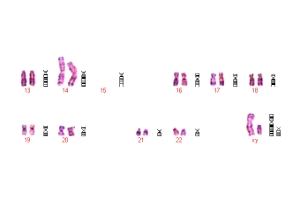 Missing two chromosomes but doing fine. A partial karyotype of a man with 44 chromosomes.
Missing two chromosomes but doing fine. A partial karyotype of a man with 44 chromosomes.
A doctor from China contacted me through this blog with some exciting news. He had found a patient with 44 chromosomes instead of the usual 46. And the patient was perfectly normal as far as anyone could tell.
The doctor contacted me because the story of how this patient ended up with 44 chromosomes mirrored my story of how humans may have gone from 48 to 46 chromosomes a million or so years ago. The idea that human chromosome reduction could happen this way was theoretical when I wrote about it. Now we have living proof that it can and does happen.
Sticking Two Chromosomes Together
At first it might seem weird that losing a couple of chromosomes had no real effect on the patient since losing even one is usually fatal. But his case is different because he didn’t really lose two chromosomes (and all of their essential genes). Instead the chromosomes ended up stuck to two other chromosomes. So he has the same genes…they are just packaged differently.
